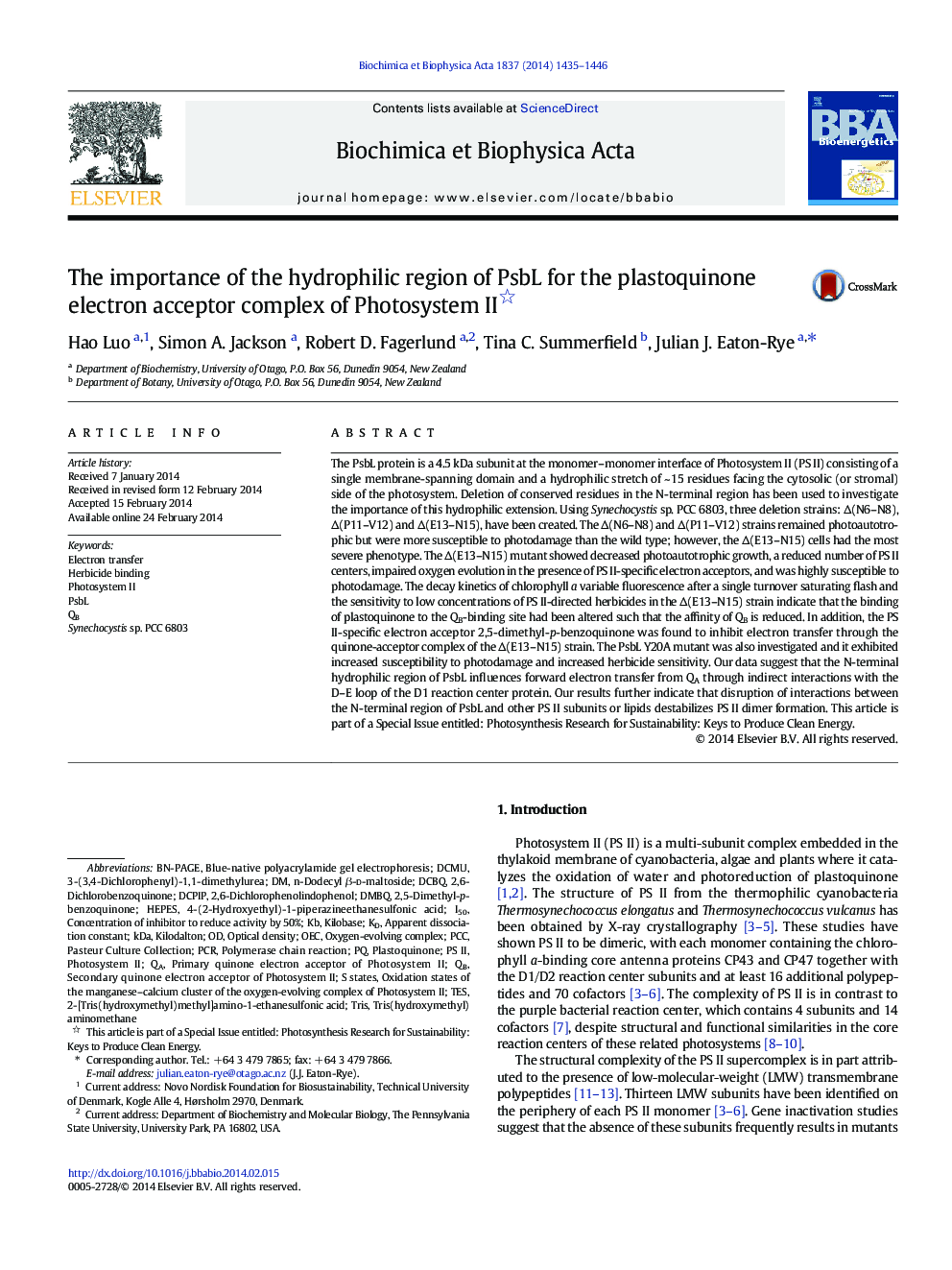| کد مقاله | کد نشریه | سال انتشار | مقاله انگلیسی | نسخه تمام متن |
|---|---|---|---|---|
| 1942167 | 1052585 | 2014 | 12 صفحه PDF | دانلود رایگان |
عنوان انگلیسی مقاله ISI
The importance of the hydrophilic region of PsbL for the plastoquinone electron acceptor complex of Photosystem II
دانلود مقاله + سفارش ترجمه
دانلود مقاله ISI انگلیسی
رایگان برای ایرانیان
کلمات کلیدی
2,5-dimethyl-p-benzoquinonePS IIDCMUTRISBN-PAGEI50DCBQOECkiloDaltonkDaSynechocystis sp. PCC 6803TESDCPIPPCCHEPESDMBQ2,6-dichlorophenolindophenol - 2،6-dichlorophenolindophenol3-(3,4-Dichlorophenyl)-1,1-dimethylurea - 3- (3،4-Dichlorophenyl) -1،1-dimethylurea4-(2-hydroxyethyl)-1-piperazineethanesulfonic acid - 4- (2-hydroxyethyl) -1-piperazineethanesulfonic acidn-dodecyl β-d-maltoside - n-dodecyl β-d-مالتوزیدblue-native polyacrylamide gel electrophoresis - الکتروفورز ژل پلی آکریل آمید آبی بومیelectron transfer - انتقال الکترونTris(hydroxymethyl)aminomethane - تریس (هیدروکسی متیل) آمینومتانapparent dissociation constant - ثابت جداسازی آشکارPhotosystem II - فتوسیستم 2Pasteur Culture Collection - مجموعه فرهنگ پاستورpolymerase chain reaction - واکنش زنجیره ای پلیمرازPCR - واکنش زنجیرهٔ پلیمرازplastoquinone - پلواستیکینونOxygen-evolving complex - پیچیده اکسیژن تکامل یافتهoptical density - چگالی نوریkilobase - کیلوبایز
موضوعات مرتبط
علوم زیستی و بیوفناوری
علوم کشاورزی و بیولوژیک
دانش گیاه شناسی
پیش نمایش صفحه اول مقاله

چکیده انگلیسی
The PsbL protein is a 4.5Â kDa subunit at the monomer-monomer interface of Photosystem II (PS II) consisting of a single membrane-spanning domain and a hydrophilic stretch of ~Â 15 residues facing the cytosolic (or stromal) side of the photosystem. Deletion of conserved residues in the N-terminal region has been used to investigate the importance of this hydrophilic extension. Using Synechocystis sp. PCC 6803, three deletion strains: â(N6-N8), â(P11-V12) and â(E13-N15), have been created. The â(N6-N8) and â(P11-V12) strains remained photoautotrophic but were more susceptible to photodamage than the wild type; however, the â(E13-N15) cells had the most severe phenotype. The Î(E13-N15) mutant showed decreased photoautotrophic growth, a reduced number of PS II centers, impaired oxygen evolution in the presence of PS II-specific electron acceptors, and was highly susceptible to photodamage. The decay kinetics of chlorophyll a variable fluorescence after a single turnover saturating flash and the sensitivity to low concentrations of PS II-directed herbicides in the Î(E13-N15) strain indicate that the binding of plastoquinone to the QB-binding site had been altered such that the affinity of QB is reduced. In addition, the PS II-specific electron acceptor 2,5-dimethyl-p-benzoquinone was found to inhibit electron transfer through the quinone-acceptor complex of the â(E13-N15) strain. The PsbL Y20A mutant was also investigated and it exhibited increased susceptibility to photodamage and increased herbicide sensitivity. Our data suggest that the N-terminal hydrophilic region of PsbL influences forward electron transfer from QA through indirect interactions with the D-E loop of the D1 reaction center protein. Our results further indicate that disruption of interactions between the N-terminal region of PsbL and other PS II subunits or lipids destabilizes PS II dimer formation. This article is part of a Special Issue entitled: Photosynthesis Research for Sustainability: Keys to Produce Clean Energy.
ناشر
Database: Elsevier - ScienceDirect (ساینس دایرکت)
Journal: Biochimica et Biophysica Acta (BBA) - Bioenergetics - Volume 1837, Issue 9, September 2014, Pages 1435-1446
Journal: Biochimica et Biophysica Acta (BBA) - Bioenergetics - Volume 1837, Issue 9, September 2014, Pages 1435-1446
نویسندگان
Hao Luo, Simon A. Jackson, Robert D. Fagerlund, Tina C. Summerfield, Julian J. Eaton-Rye,